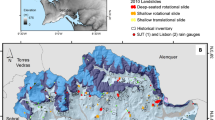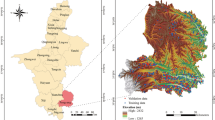Abstract
Iranian plateau is a seismically active region. Within this region, northwestern Iran is of high importance. Before proper planning for mitigating the earthquake-induced hazards can be achieved, it is necessary to identify high-risk areas in terms of susceptibility to earthquakes. In this study, landslide susceptibility in Miandoab Country was modeled using the so-called random forest algorithm (RFA) in MATLAB based on records acquired at 67 earthquake hotspots considering 9 factors affecting the earthquake occurrence (i.e., height, slope, direction, distance from fault, distance from river, distance from road, land use, geology, and precipitation). Predictive power of the model and validity of its results were evaluated using relative operating characteristic (ROC) curve and area under the curve (AUC). The assessment results showed very good accuracy of the model (0.97). It was further found that digital height layer, geology, and distance from fault impose the largest contributions into earthquake potential. The results also showed that 53%, 8.3%, and 38.4% of the study area were classified as being at low risk, moderate risk, and high risk of earthquake. Among other climatic elements, the precipitation exhibits the largest fluctuations; we proceeded to evaluate precipitation trends in the study area for a statistical period of 30 years. This was practiced by implementing Mann–Kendall nonparametric test in MATLAB. This subject-matter is especially important in Iran where the annual precipitation level is as low as 250 mm. The results showed that the precipitation follows an increasing trend in the region.





Similar content being viewed by others
Data availability
The data used in the manuscript are publicly available. Some data on www.irimo.ir/far/wd.html are available under the Iran Meteorological Organization.
References
Abungba, J., Khare, D., Pingale, S., Adjei, K., Gyamfi, C., & Odai, S. (2020). Assessment of hydro-climatic trends and variability over the Black Volta Basin in Ghana. Earth Systems and Environment. https://doi.org/10.1007/s41748-020-00171-9
Bednarick, M., Magulova, B., Matys, M., & Marschalko, M. (2010). Landslide susceptibility assessment of the Kralˇovany–Liptovsky Mikulas railway case study. Physics and Chemistry of the Earth, 35, 162–171. https://doi.org/10.1016/j.pce.2009.12.002
Breiman, L. (2001). Random forests. Machine Learning, 45(l), 5–32. http://dx.doi.org/10.1023/A:1010933404324
Chen, J., Wub, X., Finlayson, B., Webber, M., Wei, T., & Li, M. (2014). Variability and trend in the hydrology of the Yangtze River, China: Annual precipitation and runoff. Journal of Hydrology, 513, 403–412. https://doi.org/10.1016/j.jhydrol.2014.03.044
Chen, W., Li, Y., Xue, W., Shahabi, H., Li, S., Hong, H., Wang, X., Bian, H., Zhang, S., Pradhan, B., & Ahmad, B. (2019a). Modeling flood susceptibility using data-driven approaches of naïve Bayes tree, alternating decision tree, and random forest methods. Science of The Total Environment, 701. https://doi.org/10.1016/j.scitotenv.2019.134979
Chen, W., Sun, Z., & Han, J. (2019b). Landslide susceptibility modeling using integrated ensemble weights of evidence with logistic regression and random forest models. Applied Sciences, 9(1), 171. https://doi.org/10.3390/app9010171
Cutler, D. R., Edwards Jr, T. C., Beard, K. H., Cutler, A., Hess, K. T., Gibson, J., & Lawler, J. J. (2007). Random forests for classification in ecology. Ecology, 88(11), 2783–2792.https://doi.org/10.1890/07-0539.1
Dang, V., Hoang, N. D., Nguyen, L., Bui, D., & Samui, P. (2020). A novel GIS-based random forest machine algorithm for the spatial prediction of shallow landslide susceptibility. Forests, 11(1), 118. https://doi.org/10.3390/f11010118
Day, M. (1983). Doline morphology and development in Barbados. Annals of the Assiciation of American Geographers, 73(2), 206–219. https://doi.org/10.1111/j.1467-8306.1983.tb01408.x
Doe, J., Yunus, A., Bui, D., Merghadi, A., Sahana, M., Zhu, Z., Chen, C., Khosravi, K., Yang, Y., & Pham, B. (2019). Assessment of advanced random forest and decision tree algorithms for modeling rainfall-induced landslide susceptibility in the Izu-Oshima Volcanic Island, Japan. Science of The Total Environment, 662, 332–346.https://doi.org/10.1016/j.scitotenv.2019.01.221
Duhan, D., & Pandy, A. (2013). Statistical analysis of long term spatial and temporal trends of precipitation during 1901–2002 at Madhya Pradesh, India. Atmospheric Research, 122, 136–149. https://doi.org/10.1016/j.atmosres.2012.10.010
Erener, A., Mutlu, A., & Düzgün, H. S. (2016). Comparative study for landslide susceptibility mapping using GIS-based multi-criteria decision analysis (MCDA), logistic regression (LR) and association rule mining (ARM). Engineering Geology, 203, 45–55. https://doi.org/10.1016/j.enggeo.2015.09.007
Fang Sang, Y., Wang, Z., & Liu, C. H. (2014). Comparison of the MK test and EMD method for trend identification in hydrological time Series. Journal of Hydrology., 510, 293–298. https://doi.org/10.1016/j.jhydrol.2013.12.039
Feng, Q., Liu, J., & Gong, J. (2015). Urban flood mapping based on unmanned aerial vehicle remote sensing and random forest classifier—A case of Yuyao, China. Water, 7(4), 1437–1455.https://doi.org/10.3390/w7041437
Hamed, K. H., & Rao, A. R. (1998). A modified Mann-Kendall trend test for autocorrelated data. Journal of Hydrology, 204, 182–196.https://doi.org/10.1016/S0022-1694(97)00125-X
Hosmer Jr, D. W., Lemeshow, S., & Sturdivant, R. X. (2013). Applied logistic regression. 3rd Edition, vol 398. John Wiley & Sons, 528p. https://doi.org/10.1002/9781118548387. https://www.wiley.com/en-us/Applied+Logistic+Regression%2C+3rd+Edition-p-9780470582473
Iranian Landslide Working Party (ILWP). (2007). Iranian landslid list (p. 60). Forest, Rangeland and Watershed Association, Tehran, Iran.
Kendall, M. G. (1970). Rank correlation methods. (2nd ed.). New York: Hafner.
Khaliq, M. N., Ouarda, T., Gachon, P., Sushama, L., & St-Hilaire, A. (2009). Identification ofhydrologicaltrends in the presence of serial and cross correlations: A review of selected methods and their application toannual flow regimes of Canadian rivers. Journal of Hydrology, 368, 117–130. https://doi.org/10.1016/j.jhydrol.2009.01.035
Koehorst, B. A. N., Kjekstad, O., Patel, D., Lubkowski, Z., Knoeff, J. G., Akkerman, G. J. (2005). Work package 6, Determination of socio-economic impact of natural disasters. Assessing Socio-Economic Impact in Europe, 173.
Li, R., Huang, H., Yu, G., Yu, H., Bridhikitti, A., Su, T. (2020). Trends of runoff variation and effects of main causal factors in Mun River, Thailand during 1980–2018. Water, 12(3), 831. https://doi.org/10.3390/w12030831
Manafiazar, R., & Valaei, M. (2019). Comparative analysis of inequalities in urban space and urban peripheral spaces, case: Miandoab. Journal of Urban Peripheral Development, 1(1), 111–128. https://doi.org/20.1001.1.26764164.1398.1.1.10.0
Mann, H. B. (1945). Nonparametric tests against trend. Econometrica, 13, 245–259. https://doi.org/10.2307/1907187
Mohammadi, M., & Pourghasemi, H. R. (2017). Prioritization of factors affecting the occurrence of landslides and preparation of its sensitivity map using a new random forest algorithm (Case study: Part of Golestan province). Journal of Watershed Management, 8(15), 161–170. (In Persion). https://doi.org/10.29252/jwmr.8.15.161-170. http://jwmr.sanru.ac.ir/article-1-852-fa.html
Nicodemus, K. K. (2011). Letter to the editor: On the stability and ranking of predictors from random forest variable importance measures. Briefings in Bioinformatics, 12(4), 369–373. https://doi.org/10.1093/bib/bbr016
Paudel, U., & Oguchi, T. (2014). Implementation of random forest in landslide susceptibility study, a case study of the Tokamachi area, Niigata, Japan. Japan Geoscience Union Meeting, Pcaifico Yokohama, 28th April 2.
Pourghasemi, H. R., & Kerle, N. (2016). Random forests and evidential belief function-based landslide susceptibility assessment in Western Mazandaran Province, Iran. Environmental Earth Sciences, 75(3), 185. https://doi.org/10.1007/s12665-015-4950-1
Prasad, A. M., Iverson, L. R., & Liaw, A. (2006). Newer classification and regression tree techniques: Bagging and random forests for ecological prediction. Ecosystems, 9(2), 181–199. https://doi.org/10.1007/s10021-005-0054-1
Pradhan, B., Abokharima, M. H., Jebur, M. N., & Tehrany, M. S. (2014). Land subsidence susceptibility mapping at Kinta Valley (Malaysia) using the evidential belief function model in GIS. Natural Hazards, 73(2), 1019–1042. https://doi.org/10.1007/s11069-014-1128-1
Rahmati, O., Pourghasemi, H. R., & Melesse, A. -M. (2016). Application of GIS-based data-driven random forest and maximum entropy models for groundwater potential mapping: A case study at Mehran Region, Iran. Catena, 137, 360–372. https://doi.org/10.1016/j.catena.2015.10.010
Sa’adi, Z., Shahid, S., Ismail, T., Chung, E., & Wang, X. (2017). Trends analysis of rainfall and rainfall extremes in Sarawak, Malaysia using modified Mann–Kendall test. Meteorology and Atmospheric Physics, 131, 263–277. https://link.springer.com/article/10.1007/s00703-017-0564-3
Sen, P. K. (1968). Estimates of the regression coefficient based on Kendall’s tau. Journal of American Statistical Association, 63, 1379–1389. https://doi.org/10.1080/01621459.1968.10480934, https://www.tandfonline.com/doi/abs/10.1080/01621459.1968.10480934
Shahabi, H., Khezri, S., Ahmad, B. B., & Hashim, M. (2014). Landslide susceptibility mapping at central Zab basin, Iran: A comparison between analytical hierarchy process, frequency ratio and logistic regression models. Catena, 115, 55–70. https://doi.org/10.1016/j.catena.2013.11.014
Taalab, Kh., Cheng, T., & Zhang, Y. (2018). Mapping landslide susceptibility and types using Random Forest. Big Earth Data, 2(2), 159–178. https://doi.org/10.1080/20964471.2018.1472392
Theil, H. (1950). A rank-invariant method of linear and polynomial regression analysis, 3; Proceedings of Koninalijke Nederlandse Akademie van Weinenschatpen, 53, 1397–1412. confidence regions for the parameters of polynomial regression equations. In KNAW. http://en.wikipedia.org/wiki/Henri_Theil
Von Storch, H. (1995). Misuses of statistical analysis in climate research. In: Analysis of climate variability: Applications of statistical techniques, Springer-Verlag Berlin, 11-26. http://dx.doi.org/10.1007/978-3-662-03167-4_2
Zare, M., Pourghasemi, H. R., Vafakhah, M., & Pradhan, B. (2013). Landslide susceptibility mapping at Vaz Watershed (Iran) using an artificial neural network model: A comparison between multilayerperceptron (MLP) and radial basic function (RBF) algorithms. Arabian Journal of Geosciences, 6(8), 2873–2888. https://doi.org/10.1007/s12517-012-0610-x
Zhang, K., Wu, X., Niu., R, Yang, K., & Zhao, L. (2017). The assessment of landslide susceptibility mapping using random forest and decision tree methods in the Three Gorges Reservoir area, China. Environmental Earth Sciences, 76, 405. https://doi.org/10.1007/s12665-017-6731-5
Acknowledgements
We would like to appreciate Iran Meteorological Organization for their collaboration in this research.
Author information
Authors and Affiliations
Corresponding author
Ethics declarations
Consent to participate
Not applicable.
Consent for publication
All authors have agreed to publish this manuscript with EMAS Journal.
Conflict of interest
The authors declare no competing interests.
Additional information
Publisher's Note
Springer Nature remains neutral with regard to jurisdictional claims in published maps and institutional affiliations.
Rights and permissions
About this article
Cite this article
Rezapour Andabili, N., Safaripour, M. Identification of precipitation trend and landslide susceptibility analysis in Miandoab County using MATLAB. Environ Monit Assess 194, 472 (2022). https://doi.org/10.1007/s10661-022-10069-w
Received:
Accepted:
Published:
DOI: https://doi.org/10.1007/s10661-022-10069-w




